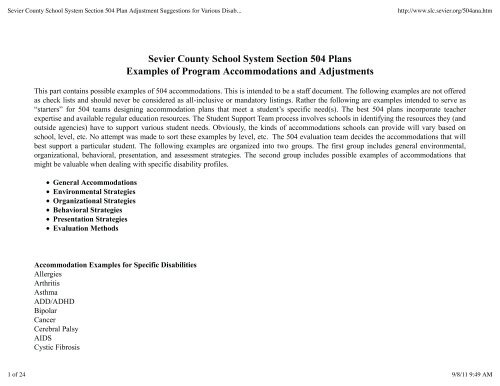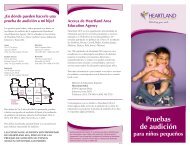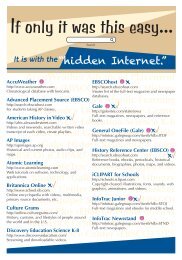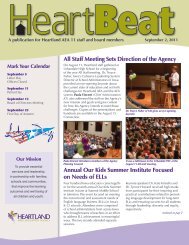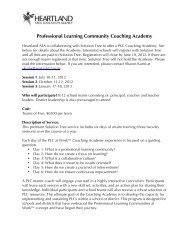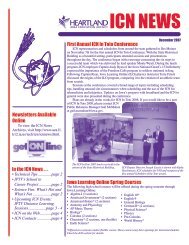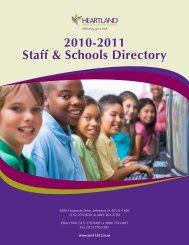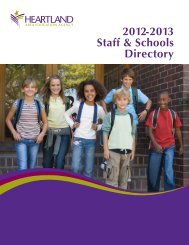Sevier County School System Section 504 Plans ... - Heartland AEA 11
Sevier County School System Section 504 Plans ... - Heartland AEA 11
Sevier County School System Section 504 Plans ... - Heartland AEA 11
Create successful ePaper yourself
Turn your PDF publications into a flip-book with our unique Google optimized e-Paper software.
<strong>Sevier</strong> <strong>County</strong> <strong>School</strong> <strong>System</strong> <strong>Section</strong> <strong>504</strong> Plan Adjustment Suggestions for Various Disab... http://www.slc.sevier.org/<strong>504</strong>ana.htm<br />
<strong>Sevier</strong> <strong>County</strong> <strong>School</strong> <strong>System</strong> <strong>Section</strong> <strong>504</strong> <strong>Plans</strong><br />
Examples of Program Accommodations and Adjustments<br />
This part contains possible examples of <strong>504</strong> accommodations. This is intended to be a staff document. The following examples are not offered<br />
as check lists and should never be considered as all-inclusive or mandatory listings. Rather the following are examples intended to serve as<br />
“starters” for <strong>504</strong> teams designing accommodation plans that meet a student’s specific need(s). The best <strong>504</strong> plans incorporate teacher<br />
expertise and available regular education resources. The Student Support Team process involves schools in identifying the resources they (and<br />
outside agencies) have to support various student needs. Obviously, the kinds of accommodations schools can provide will vary based on<br />
school, level, etc. No attempt was made to sort these examples by level, etc. The <strong>504</strong> evaluation team decides the accommodations that will<br />
best support a particular student. The following examples are organized into two groups. The first group includes general environmental,<br />
organizational, behavioral, presentation, and assessment strategies. The second group includes possible examples of accommodations that<br />
might be valuable when dealing with specific disability profiles.<br />
General Accommodations<br />
Environmental Strategies<br />
Organizational Strategies<br />
Behavioral Strategies<br />
Presentation Strategies<br />
Evaluation Methods<br />
Accommodation Examples for Specific Disabilities<br />
Allergies<br />
Arthritis<br />
Asthma<br />
ADD/ADHD<br />
Bipolar<br />
Cancer<br />
Cerebral Palsy<br />
AIDS<br />
Cystic Fibrosis<br />
1 of 24 9/8/<strong>11</strong> 9:49 AM
<strong>Sevier</strong> <strong>County</strong> <strong>School</strong> <strong>System</strong> <strong>Section</strong> <strong>504</strong> Plan Adjustment Suggestions for Various Disab... http://www.slc.sevier.org/<strong>504</strong>ana.htm<br />
Deaf/Hearing Impairment<br />
Diabetes<br />
Drugs/alcohol<br />
Emotionally Disturbed<br />
Encopresis/Enuresis<br />
Epilepsy<br />
Hearing Impairment<br />
Learning Disability<br />
Leukemia<br />
Orthopedically Impaired<br />
Student with Special Health Care Needs<br />
Temporarily Disabled<br />
Tourette's Syndrome<br />
Traumatic Brain Injury<br />
Tuberculosis<br />
Visual Impairment<br />
Weight (obesity, anorexia, bulimia)<br />
General Accommodations<br />
General program accommodations/adjustments or services are always made on a case-by-case basis and individualized. Accommodations are<br />
to be reasonable. Accommodations are intended to provide persons with disabilities compensation for their functional limitation(s) due to a<br />
mental or physical impairment. Where <strong>Section</strong> <strong>504</strong> is concerned, accommodations are made to bring a student with a disability to the same<br />
starting point as a non-disabled student. Consequently, the accommodations defined in a <strong>Section</strong> <strong>504</strong> plan are those interventions that are over<br />
and above the accommodations available to all students.<br />
Environmental Strategies<br />
Provide a structured learning environment<br />
Make separate "space" for different types of tasks<br />
Possible adapting of non-academic times such as lunch, recess, and physical education<br />
Change student seating<br />
Utilize a study carrel<br />
Alter location or personal or classroom supplies for easier access or to minimize distraction<br />
2 of 24 9/8/<strong>11</strong> 9:49 AM
<strong>Sevier</strong> <strong>County</strong> <strong>School</strong> <strong>System</strong> <strong>Section</strong> <strong>504</strong> Plan Adjustment Suggestions for Various Disab... http://www.slc.sevier.org/<strong>504</strong>ana.htm<br />
Organizational Strategies<br />
Model and reinforce organizational systems (i.e. color-coding)<br />
Write out homework assignments, check student's recording of assignments<br />
Tailor homework assignments toward student strengths<br />
Set time expectations for assignments<br />
Provide clues such as clock faces indicating beginning and ending times<br />
Behavioral Strategies<br />
Use behavioral management techniques consistently within a classroom and across classes<br />
Implement behavioral/academic contracts<br />
Utilize positive verbal and/or nonverbal reinforcements<br />
Utilize logical consequences<br />
Confer with the student's parents (and student as appropriate)<br />
Establish a home/school communication system for behavior monitoring<br />
Post rules and consequences for classroom behavior<br />
Put student on daily/weekly progress report/contract<br />
Reinforce self-monitoring and self-recording of behaviors<br />
Presentation Strategies<br />
Tape lessons so the student can listen to them again; allow students to tape lessons<br />
Use computer-aided instruction and other audiovisual equipment<br />
Select alternative textbooks, workbooks, or provide books on tape<br />
Highlight main ideas and supporting details in the book<br />
Provide copied material for extra practice (i.e. outlines, study guides)<br />
Prioritize drill and practice activities for saliency<br />
Vary the method of lesson presentation using multi-sensory techniques:<br />
a) lecture plus overhead/board demonstration support<br />
3 of 24 9/8/<strong>11</strong> 9:49 AM
<strong>Sevier</strong> <strong>County</strong> <strong>School</strong> <strong>System</strong> <strong>Section</strong> <strong>504</strong> Plan Adjustment Suggestions for Various Disab... http://www.slc.sevier.org/<strong>504</strong>ana.htm<br />
b) small groups required to produce a written product<br />
c) large groups required to demonstrate a process<br />
d) audio-visual (i.e. filmstrips, study prints) methods<br />
e) peer tutors or cross-age tutors<br />
f) demonstrations, simulations<br />
g) experiments<br />
h) games<br />
1-to-1 instruction with other available adults<br />
Ask student to repeat/paraphrase context to check understanding<br />
Arrange for a mentor to work with student in his or her interest area or area of greatest strength<br />
Provide peer tutoring<br />
Simplify and repeat instructions about in-class and homework assignments<br />
Vary instructional pace<br />
Reinforce the use of compensatory strategies, i.e. pencil grip, mnemonic devices, “spell check”<br />
Vary kind of instructional materials used<br />
Assess whether student has the necessary prerequisite skills. Determine whether materials are appropriate to the student's current<br />
functioning levels<br />
Reinforce study skill strategies (survey, read, recite, review)<br />
Introduce definition of new terms/vocabulary and review to check for understanding<br />
Be aware of student's preferred learning style and provide matching instruction materials<br />
Evaluation Methods<br />
Limit amount of material presented on a single page<br />
Provide a sample or practice test<br />
Provide for oral testing<br />
Provide tests in segments so that student hands in one segment before receiving the next part<br />
Provide personal copy of test tools and allow for color-coding/highlighting<br />
Accommodation Examples for Specific Disabilities<br />
4 of 24 9/8/<strong>11</strong> 9:49 AM
<strong>Sevier</strong> <strong>County</strong> <strong>School</strong> <strong>System</strong> <strong>Section</strong> <strong>504</strong> Plan Adjustment Suggestions for Various Disab... http://www.slc.sevier.org/<strong>504</strong>ana.htm<br />
Here are some examples of accommodations and services that might be considered for specific disability profiles. Please keep in mind that<br />
these examples are not intended to be all-inclusive or mandatory. Do not use these examples as a “checklist” as accommodations are to be<br />
made on a case-by-case basis specific to individual need. Please also remember that the mere presence of these conditions does not<br />
automatically qualify a student for a <strong>Section</strong> <strong>504</strong> plan. The disability must significantly limit one or more life functions before a <strong>504</strong> plan is to<br />
be considered. Additionally, this disability must impact the student so that he or she is not afforded access and benefit of programs and<br />
services equal to that of non-disabled students.<br />
Allergies<br />
EXAMPLE: The student has severe allergic reactions to certain pollens and foods. For purposes of this example the condition substantially<br />
limits the major life activity of breathing and may interfere with the student's ability to get to school or participate once there.<br />
Possible Accommodations and Services:<br />
Avoid allergy-causing substances: soap, weeds, pollen, food<br />
Inservice necessary persons: dietary people, peers, coaches, laundry service people, etc.<br />
Allow time for shots/clinic appointments<br />
Use air purifiers<br />
Adapt physical education curriculum during high pollen time<br />
Improve room ventilation (i.e. when remodeling has occurred and materials may cause an allergy)<br />
Develop health care and/or emergency plans<br />
Address pets/animals in the classroom<br />
Involve school health consultant in school related health issues<br />
Train for proper dispensing of medications; monitor and/or distribute medications; monitor for side effects<br />
Arthritis<br />
EXAMPLE: A student with severe arthritis may have persistent pain, tenderness or swelling in one or more joints. A student experiencing<br />
arthritic pain may require a modified physical education program. For purposes of this example, the condition substantially limits the major<br />
life activity of performing manual tasks.<br />
Possible Accommodations and Services:<br />
Provide a rest period during the day<br />
5 of 24 9/8/<strong>11</strong> 9:49 AM
<strong>Sevier</strong> <strong>County</strong> <strong>School</strong> <strong>System</strong> <strong>Section</strong> <strong>504</strong> Plan Adjustment Suggestions for Various Disab... http://www.slc.sevier.org/<strong>504</strong>ana.htm<br />
Accommodate for absences for doctors' appointments<br />
Provide assistive devices for writing (e.g. pencil grips, non-skid surface, typewriter/computer, etc.)<br />
· Adapt physical education curriculum<br />
Administer medication following medication administration protocols<br />
Train student for proper dispensing of medications; monitor and/or distribute medications; monitor for side effects<br />
Arrange for assistance with carrying books, lunch tray, etc.<br />
Provide book caddie<br />
Implement movement plan to avoid stiffness<br />
Provide seating accommodations<br />
Allow extra time between classes<br />
Provide locker assistance<br />
Provide modified eating utensils<br />
Develop health care plan and emergency plan<br />
Provide for accommodations for writing tasks; a note taker, a computer or tape recorder for note-taking<br />
Make available access to wheelchair/ramps and school van for transportation<br />
Provide more time for massage or exercises<br />
Adjust recess time<br />
Provide peer support groups<br />
Arrange for instructional aide support<br />
Install handle style door knobs (openers)<br />
Record lectures/presentations<br />
Have teachers provide outlines of presentations<br />
Issue Velcro fasteners for bags<br />
Obtain padded chairs<br />
Provide a more comfortable style of desk<br />
Adjust attendance policy, if needed<br />
Provide a shorter school day<br />
Furnish a warmer room and sit student close to the heat<br />
Adapt curriculum for lab classes<br />
Supply an extra set of books for home use and keep a set at school<br />
Let student give reports orally rather than in writing<br />
Provide an awareness program for staff and students<br />
Monitor any special dietary considerations<br />
Involve school health consultants in school health related issues<br />
Provide post-secondary or vocational transition planning<br />
6 of 24 9/8/<strong>11</strong> 9:49 AM
<strong>Sevier</strong> <strong>County</strong> <strong>School</strong> <strong>System</strong> <strong>Section</strong> <strong>504</strong> Plan Adjustment Suggestions for Various Disab... http://www.slc.sevier.org/<strong>504</strong>ana.htm<br />
Asthma<br />
EXAMPLE: A student has been diagnosed as having severe asthma. The doctor has advised the student not to participate in physical activity<br />
outdoors. For purposes of this example, the disability limits the major life activity of breathing.<br />
Possible Accommodations and Services:<br />
Adapt activity level for recess, physical education, etc.<br />
Provide inhalant therapy assistance<br />
Train for proper dispensing of medications; monitor and/or distribute medications; monitor for side effects<br />
Remove allergens (e.g. hair spray, lotions, perfumes, paint, latex)<br />
Make field trips that might aggravate the condition non-mandatory and supplement with videos, audiotapes, movies, etc.<br />
Accommodate medical absence by providing makeup work, etc.<br />
Adjust for administration of medications<br />
Provide access to water, gum, etc.<br />
Adapt curriculum expectations when needed (i.e. science class, physical education, etc.)<br />
Develop health care and emergency plans<br />
Have peers available to carry materials to and from classes (e.g. lunch tray, books)<br />
Provide rest periods<br />
Make health care needs known to appropriate staff<br />
Provide indoor space for before and after school activities<br />
Have a locker location which is centralized and free of atmosphere changes<br />
Adapt attendance policies, school day duration, or 180-day requirement, if needed<br />
Place student in most easily controlled environment<br />
Attention Deficit Disorder (ADD) and<br />
Attention Deficit Hyperactive Disorder (ADHD)<br />
EXAMPLE: The student does not meet eligibility requirements under IDEA as emotionally disturbed, learning disabled or other health<br />
impaired. A doctor regards the student as having ADD, and for purposes of this example, the disability limits the major life activity of<br />
learning. The student, because of his disability, is unable to participate in the school's programs to the same degree as students without<br />
disabilities and therefore is substantially limited by the disability.<br />
7 of 24 9/8/<strong>11</strong> 9:49 AM
<strong>Sevier</strong> <strong>County</strong> <strong>School</strong> <strong>System</strong> <strong>Section</strong> <strong>504</strong> Plan Adjustment Suggestions for Various Disab... http://www.slc.sevier.org/<strong>504</strong>ana.htm<br />
Possible Accommodations and Services:<br />
Seat the student away from distractions and in close proximity to the teacher<br />
State classroom rules, post in an obvious location and enforce consistently<br />
Use simple, concise instructions with concrete steps<br />
Provide seating options<br />
Tolerate (understand the need) excessive movement<br />
Provide a peer tutor/helper<br />
Teach compensatory strategies<br />
Train for proper dispensing of medications; monitor and/or distribute medications; monitor for side effects<br />
Monitor for stress and fatigue; adjust activities<br />
Adjust assignments to match attention span, etc.<br />
Vary instructional pace<br />
Vary instructional activities frequently<br />
Provide supervision during transitions, disruptions, field trips<br />
Model the use of study guides, organizing tools<br />
Accommodate testing procedures; lengthy tests might be broken down into several shorter administrations<br />
Provide counseling and prompt feedback on both successes and areas needing improvement<br />
Initiate frequent parent communication<br />
Establish a school/home behavior management program<br />
Provide training for staff<br />
Have the student use an organizer; train in organizational skills<br />
Establish a nonverbal cue between teacher and student for behavior monitoring<br />
Assign chores/duties around room/school<br />
Adapt environment to avoid distractions<br />
Reinforce appropriate behavior<br />
Have child work alone or in a study carrel during high stress times<br />
Highlight required or important information/directions<br />
Provide a checklist for student, parents, and/or teacher to record assignments of completed tasks<br />
Use a timer to assist student to focus on given task or number of problems in time allotted. Stress that problems need to be<br />
done correctly.<br />
Have student restate or write directions/instructions<br />
Allow student to respond in variety of different modes (i.e. may place answers for tests on tape instead of paper)<br />
Give student opportunity to stand/move while working<br />
Provide additional supervision to and from school<br />
8 of 24 9/8/<strong>11</strong> 9:49 AM
<strong>Sevier</strong> <strong>County</strong> <strong>School</strong> <strong>System</strong> <strong>Section</strong> <strong>504</strong> Plan Adjustment Suggestions for Various Disab... http://www.slc.sevier.org/<strong>504</strong>ana.htm<br />
Adapt student's work area to help screen out distracting stimuli<br />
Grade for content integrity, and not just neatness/presentation<br />
Schedule subjects which require greater concentration early in the day<br />
Supply small rewards to promote behavior change<br />
Avoid withholding physical activity as a negative reinforcer<br />
Allow for periodic, frequent physical activity, exercise, etc.<br />
Determine trigger points and prevent action leading to trigger points<br />
Provide for socialization opportunities, such as circle of friends<br />
Bipolar Disorder<br />
EXAMPLE: The student was diagnosed as having a bipolar disorder, however the severity (frequency, intensity, duration considerations) of<br />
the condition did not qualify the student for IDEA. A properly convened <strong>504</strong> committee determined that the condition did significantly impair<br />
the major life activity of learning and fashioned a <strong>504</strong> plan for the student. Here are some possible accommodations for this scenario.<br />
Possible Accommodations and Services:<br />
Cancer<br />
Break down assignments into manageable parts with clear and simple directions,given one at a time.<br />
Plan advanced preparation for transitions.<br />
Monitor clarity of understanding and alertness.<br />
Allow most difficult subjects at times when student is most alert.<br />
Provide extra time on tests, class work, and homework if needed.<br />
Strategies in place for unpredictable mood swings.<br />
Provide appropriate staff with training on bipolar disorder.<br />
Create awareness by staff of potential victimization from other students.<br />
Implement a crisis intervention plan for extreme cases where student gets out of control and may do something impulsive or dangerous.<br />
Provide positive praise and redirection.<br />
Report any suicidal comments to counselor/psychologist immediately.<br />
Consider home instruction for times when the student’s mood disorder makes it impossible for him to attend school for an extended<br />
period.<br />
9 of 24 9/8/<strong>11</strong> 9:49 AM
<strong>Sevier</strong> <strong>County</strong> <strong>School</strong> <strong>System</strong> <strong>Section</strong> <strong>504</strong> Plan Adjustment Suggestions for Various Disab... http://www.slc.sevier.org/<strong>504</strong>ana.htm<br />
EXAMPLE: A student with a long-term medical problem may require special accommodations. Such a condition as cancer may substantially<br />
limit the major life activities of learning and caring for oneself. For example, a student with cancer may need a class schedule that allows for<br />
rest and recuperation following chemotherapy.<br />
Possible Accommodations and Services:<br />
Adjust attendance policies<br />
Limit numbers of classes taken; accommodate scheduling needs (breaks, etc.)<br />
Send teacher/tutor to hospital, as appropriate<br />
Take whatever steps are necessary to accommodate student's involvement in extra-curricular activities if they are otherwise qualified<br />
Adjust activity level and expectations in classes based on physical limitations; don't require activities that are too physically taxing<br />
Train for proper dispensing of medications; monitor and/or distribute medications; monitor for side effects<br />
Provide appropriate assistive technology<br />
Provide dietary accommodations<br />
Provide a private area in which to rest<br />
Shorten school day<br />
Arrange for home tutoring following treatment<br />
Send additional set of texts and assignments to hospital schools<br />
Tape lessons. Accept the fact that the lessons and content-area tests may not be appropriate; the student is learning many life lessons<br />
through this experience.<br />
Adjust schedule to include rest breaks<br />
Provide counseling; establish peer group support<br />
Adapt physical education<br />
Provide access to school health services<br />
Provide awareness training to appropriate staff and students<br />
Develop health care emergency plan to deal with getting sick at school<br />
Offer counseling for death and dying to peers/teachers/staff<br />
Furnish a peer tutor<br />
Provide student with a student buddy for participation in sports<br />
Initiate a free pass system from the classroom<br />
Provide lessons using mastery learning techniques<br />
Provide individual school counseling<br />
Begin friendship groups for the student<br />
Provide teachers with counseling, emphasizing positive attitudes<br />
Have a health plan for care of mediport/any other intravenous lines and medical needs<br />
10 of 24 9/8/<strong>11</strong> 9:49 AM
<strong>Sevier</strong> <strong>County</strong> <strong>School</strong> <strong>System</strong> <strong>Section</strong> <strong>504</strong> Plan Adjustment Suggestions for Various Disab... http://www.slc.sevier.org/<strong>504</strong>ana.htm<br />
Plan ongoing communication about school events<br />
Notify parents of communicable diseases in school<br />
Designate a person in school to function as liaison with parents as a means of updating changing health status<br />
Cerebral Palsy<br />
EXAMPLE: The student has serious difficulties with fine and gross motor skills. A wheelchair is used for mobility. For purposes of this<br />
example, the condition substantially limits the major life activity of walking. Cognitive skills are intact.<br />
Possible Accommodations and Services:<br />
Provide assistive technology devices<br />
Arrange for use of ramps and elevators<br />
Allow for extra time between classes<br />
Assist with carrying books, lunch trays, etc.<br />
Adapt physical education curriculum<br />
Provide for physical therapy as appropriate. Such therapy needs to relate directly to "life skills."<br />
Train for proper dispensing of medications; monitor and/or distributed medications; monitor for side effects<br />
Adapt eating utensils<br />
Initiate a health care plan that also addresses emergency situations<br />
Train paraprofessionals in the case of this student (i.e. feeding, diapering, transporting to and from the wheelchair)<br />
Adapt assignments<br />
Educate peers/staff with parent/student permission<br />
Ensure that programs conducted in the basement or on second or third floor levels are accessible<br />
Ensure that bathroom facilities, sinks and water fountains are readily accessible.<br />
Provide post-secondary or vocational transition planning.<br />
Chronic Infectious Diseases (i.e. Acquired Immune Deficiency Syndrome (AIDS)<br />
EXAMPLE: The student frequently misses school and does not have the strength to attend a full day. For purposes of this example, the<br />
student has a record of a disability, which substantially limits the major life activities of learning and working. Please review applicable<br />
District policies.<br />
<strong>11</strong> of 24 9/8/<strong>11</strong> 9:49 AM
<strong>Sevier</strong> <strong>County</strong> <strong>School</strong> <strong>System</strong> <strong>Section</strong> <strong>504</strong> Plan Adjustment Suggestions for Various Disab... http://www.slc.sevier.org/<strong>504</strong>ana.htm<br />
Possible Accommodations and Services:<br />
Inservice staff and students about the disease, how it is transmitted and how it is treated. (Consult appropriate District policies)<br />
Apply universal precautions<br />
Administer medications following medication administration protocols, train for proper dispensing of medications; monitor and/or<br />
distribute medications; monitor for side effects<br />
Adjust attendance policies<br />
Adjust schedule or shorten day<br />
Provide rest periods<br />
Adapt physical education curriculum<br />
Establish routine communication with health professionals, area nurse, and home<br />
Develop health-care and emergency plan<br />
Consult with doctor, parents, teachers, area nurse and administrators<br />
Train appropriate teachers on medical/emergency procedures<br />
Provide two-way audio/video link between home and classroom via computer, etc.<br />
Arrange for an adult tutor at school or home<br />
Adapt assignments and tests<br />
Provide an extra set of textbooks for home<br />
Provide staff training on confidentiality<br />
Provide education and support for peers regarding issues of death and dying<br />
Provide transportation to and from school if needed as a related service<br />
Tape books or provide a personal reader<br />
Arrange to communicate with a home computer with e-mail<br />
Notify parents of communicable disease in the classroom<br />
Arrange for participation in a support group<br />
Provide for post-secondary employment transitions for secondary students<br />
Foster supportive community attitudes regarding the District's need to provide education to HIV positive/AIDS students<br />
Develop and promote a nondiscriminatory classroom climate and supportive student attitudes<br />
Promote the most supportive, least restrictive educational program<br />
Initiate a "Kids on the Block" AIDS program<br />
Videotape classroom teaching<br />
Provide a peer support group to encourage communication<br />
Involve school health consultant in school-related health issues<br />
12 of 24 9/8/<strong>11</strong> 9:49 AM
<strong>Sevier</strong> <strong>County</strong> <strong>School</strong> <strong>System</strong> <strong>Section</strong> <strong>504</strong> Plan Adjustment Suggestions for Various Disab... http://www.slc.sevier.org/<strong>504</strong>ana.htm<br />
Cystic Fibrosis<br />
EXAMPLE: This student is a new enrollee at your school and has an extensive medical history. He has significant difficulty breathing and<br />
will often be absent due to respiratory infection. While medical needs can be easily documented on a health plan, his educational needs also<br />
need to be accommodated. For purposes of this example, learning is the major life activity that is substantially impaired.<br />
Possible Accommodations and Services:<br />
Train for proper dispensing of medications; monitor and/or distribute medications; monitor for side effects<br />
Create a health care plan for management of acute and chronic phases<br />
Promote good communication between parents, hospital, home and school on school assignments<br />
Shorten the school day<br />
Adapt physical education activities<br />
Apply universal precautions, correct disposal of fluids<br />
Recognize need for privacy for “good coughing”<br />
Educate staff and peers<br />
Deaf/Hearing Impairment<br />
EXAMPLE: A student was diagnosed with a substantial hearing impairment at a very early age. Therefore, he has both a hearing loss and a<br />
mild speech impediment. He compensates through both lip reading and sign language. Academic abilities test in the average range.<br />
Possible Accommodations and Services:<br />
Allow for written direction/instructions in addition to oral presentation<br />
Ensure delivery of instruction facing the student to allow lip reading<br />
Provide visual information as primary mode of instruction<br />
Allow for provision of interpreter services<br />
Install acoustical tile, carpeting<br />
Seat in a location with minimal background noise<br />
Provide paper and pencil/pen to write/draw requests when needed<br />
Facilitate acquisition of TDDs and related assistive technology<br />
Allow for extra time between classes<br />
Provide post-secondary or vocational transition planning<br />
13 of 24 9/8/<strong>11</strong> 9:49 AM
<strong>Sevier</strong> <strong>County</strong> <strong>School</strong> <strong>System</strong> <strong>Section</strong> <strong>504</strong> Plan Adjustment Suggestions for Various Disab... http://www.slc.sevier.org/<strong>504</strong>ana.htm<br />
Diabetes<br />
EXAMPLE: A sixth grader with juvenile diabetes requires accommodation to maintain optimal blood sugar. His mom provides the crackers<br />
and juice to be used at "break" time and before physical education class. She asks that teachers remind him to eat at a certain time of the<br />
morning if he does not pay attention to the beeper on his watch. The youngster is very self sufficient; while he is able to monitor his own<br />
blood sugar now, he prefers to do this privately. Therefore, mom asks that the equipment and a notebook/log be stored in a nearby file cabinet<br />
and the youngster be allowed to go into the hall with the equipment to check his blood sugar twice a day. She also asks that his teacher allow<br />
him to use the bathroom as needed.<br />
Possible Accommodations and Services:<br />
· Health care plan for management of condition in the school setting and in emergencies<br />
· Educate staff to signs/symptoms of insulin reaction/hypoglycemia; hunger, shakiness, sweatiness, change in face color, disorientation,<br />
drowsiness Do not leave the child alone if he/she is feeling poorly; walk to the office or clinic with the student.<br />
· Train for proper dispensing of medications; monitor and/or distribute medications; monitor for side effects; communicate systematically<br />
and frequently with parents<br />
· Adapt physical education activities<br />
· Store equipment and documentation in a readily accessible location for student, parent and area nurse or clinic aid<br />
· Accommodate food access/meal schedules rigorously<br />
· Allow access to bathroom facilities<br />
Drugs and Alcohol<br />
EXAMPLE: The student has used drugs and alcohol for many years. This problem has affected the major life activities of learning and caring<br />
for oneself. The student is presently not using drugs or alcohol and is in a rehabilitation program. If the student is not using drugs or alcohol,<br />
he or she could qualify for accommodations or services under <strong>Section</strong> <strong>504</strong>.<br />
Possible Accommodations and Services:<br />
Provide copies of texts and assignments to treatment facility<br />
Arrange for periodic home-school contacts<br />
Establish daily/weekly assignments monitoring system<br />
Communicate with treatment facility; pursue transition services available through the treatment facility<br />
Provide/arrange for counseling<br />
14 of 24 9/8/<strong>11</strong> 9:49 AM
<strong>Sevier</strong> <strong>County</strong> <strong>School</strong> <strong>System</strong> <strong>Section</strong> <strong>504</strong> Plan Adjustment Suggestions for Various Disab... http://www.slc.sevier.org/<strong>504</strong>ana.htm<br />
Establish peer support group<br />
Dismiss from school for treatment without punitive measures<br />
Ensure strong link with school counselor<br />
Arrange for access to treatment at private or public facilities.<br />
Integrate a student assistance program into the classroom<br />
Inservice faculty/staff with parent/student permission<br />
Provide post-secondary or vocational transition planning<br />
Provide ongoing support around chemical dependency in conjunction with other agencies<br />
Train for proper dispensing of medications; monitor and/or distribute medications; monitor for side effects<br />
Emotionally Disturbed<br />
EXAMPLE: An emotionally disturbed student may need an adjusted class schedule to allow time for regular counseling or therapy. For<br />
purposes of this example, the condition substantially limits the individual's major life activity of learning.<br />
Possible Accommodations and Services:<br />
Train for proper dispensing of medications; monitor and/or distribute medications; monitor for side effects<br />
Maintain weekly/daily journals for self-recording of behavior<br />
Establish home-school communication system<br />
Schedule periodic meetings with home and treatment specialists<br />
Provide carry-over of treatment plans into school environment<br />
Assist with inter-agency referrals<br />
Utilize behavior management programs<br />
Develop contracts for student behavior<br />
Post rules for classroom behaviors; teach expectations<br />
Provide counseling, social skills instruction<br />
Reinforce replacement behaviors<br />
Educate other students/staff/school personnel<br />
Foster carryover of treatment plans to home environment<br />
Reinforce positive behavior<br />
Schedule shorter study/work periods according to attention span capabilities<br />
Be consistent in setting expectations and following up on reinforcements/consequences<br />
Provide post-secondary or vocational transition planning<br />
15 of 24 9/8/<strong>11</strong> 9:49 AM
<strong>Sevier</strong> <strong>County</strong> <strong>School</strong> <strong>System</strong> <strong>Section</strong> <strong>504</strong> Plan Adjustment Suggestions for Various Disab... http://www.slc.sevier.org/<strong>504</strong>ana.htm<br />
Encopresis/Enuresis<br />
EXAMPLE: A student who will urinate or defecate in clothes. Not to be confused with physical incontinence, but only to a needed behavior<br />
change (i.e. toilet training, bowel/bladder retraining).<br />
Possible Accommodations:<br />
Maintain low key responses<br />
Have a change of clothes available at school in the clinic or alternative location<br />
Plan a consistent response to events; send student to clinic or alternative location for clean-up and change of clothes; while wearing<br />
latex/rubber gloves, place soiled clothes in a plastic bag; call parent and make arrangements for soiled items to be returned home<br />
Observe for consistent trigger events<br />
Support bowel/bladder retraining program that is recommended by the physician<br />
Epilepsy<br />
EXAMPLE: The student is on medication for seizure activity, but experiences several petit mal seizures each month. This condition<br />
substantially limits the major life activity of learning.<br />
Possible Accommodations and Services:<br />
Call parent and document the characteristics of each seizure<br />
Assess breathing after seizure<br />
Train for proper dispensing of medications; monitor and/or distribute medications; monitor for side effects<br />
Train staff and students and prepare an emergency plan<br />
Anticipate recovery process should a seizure occur. Move seating/clear space during seizure. Do not insert objects into the student's<br />
mouth during seizure; administer no fluids if student is unconscious. Turn the unconscious student on his or her side to avoid aspiration<br />
of vomit. Provide rest time and return to academic considerations following seizure. Arrange a buddy system, especially for field trips<br />
Avoid portable chalk boards or furniture that would topple over easily<br />
Provide an alternative recess, adapt activities such as climbing and/or swimming<br />
16 of 24 9/8/<strong>11</strong> 9:49 AM
<strong>Sevier</strong> <strong>County</strong> <strong>School</strong> <strong>System</strong> <strong>Section</strong> <strong>504</strong> Plan Adjustment Suggestions for Various Disab... http://www.slc.sevier.org/<strong>504</strong>ana.htm<br />
Plan for academic make-up work<br />
Alter door openings to allow access from the outside (i.e. bathroom stall doors that swing both ways)<br />
Observe for consistent triggers (e.g. smells, bright light, perfume, hair spray)<br />
Provide post-secondary or vocational transition planning<br />
Hearing Impairment<br />
EXAMPLE: A parent is hearing impaired and requests, access to school sponsored activities. The District makes accommodations by<br />
providing interpreter services for the parent to participate effectively in school-sponsored events or meetings about the student.<br />
Possible Accommodations and Services:<br />
Provide an interpreter for those school events where accommodations may be necessary/are requested<br />
Make alternative arrangements for home-school contacts/communication<br />
Assist with locating peer or support groups<br />
Use written notes for communication<br />
Arrange with phone company for assistive devices on public phones<br />
Provide information on assistive technology; acquire assistive equipment for school use<br />
Provide in-house TDD or relay services to receive/communicate efficiently<br />
Provide post-secondary or vocational transition planning<br />
Learning Disabilities<br />
Individual profiles of learning strengths and weaknesses will vary. THE EXAMPLE: The student has a learning disability that impacts her<br />
ability to read. She has more difficulty with word decoding and spelling than reading comprehension. Thus, completing reading tasks is<br />
difficult and slow. She is currently a student receiving special education services.<br />
Possible Accommodations and Services:<br />
Provide lower-readability materials covering course context<br />
Provide extended time on tests<br />
Arrange for student/volunteer readers<br />
Provide information on accessing materials through recordings for the Blind and Dyslexic (i.e. books on tape)<br />
17 of 24 9/8/<strong>11</strong> 9:49 AM
<strong>Sevier</strong> <strong>County</strong> <strong>School</strong> <strong>System</strong> <strong>Section</strong> <strong>504</strong> Plan Adjustment Suggestions for Various Disab... http://www.slc.sevier.org/<strong>504</strong>ana.htm<br />
Allow access to spell checkers and/or word processing<br />
Provide information on accommodations for college-entrance/qualifying exams (i.e. PSAT)<br />
Written directions in addition to oral<br />
Clearly sequenced instruction<br />
Visual graphs/charts/diagrams to support instruction<br />
Provision of computer access<br />
Seating toward the instructor<br />
Support/suggestions relative to post-secondary/career options<br />
Support in the use of organizational/time-management strategies<br />
Support in the use of strategies to assist memory and problem-solving<br />
Use of multi-sensory instructional methods (i.e. visual graphs and charts to accompany oral presentation)<br />
Provide post-secondary or vocational transition planning<br />
Leukemia<br />
EXAMPLE: The student has recently been diagnosed with leukemia and requires frequent hospitalization. The condition substantially limits<br />
the major life activity of learning and caring for oneself.<br />
Possible Accommodations and Services:<br />
Involve area nurse in assessing current limitations and development of health plan<br />
Provide homebound instruction if needed<br />
Provide the student with an adjusted school day<br />
Make needed accommodations during physical education/recess<br />
Provide rest periods<br />
Have medical services and medication available at school. Train for proper dispensing of medications; monitor and/or distribute<br />
medications; monitor for side effects<br />
Support the proper diet as per physical recommendation<br />
With parent/student permission, have area nurse to educate teachers/staff/peers<br />
Notify parents of existing communicable diseases at school (i.e. chicken pox, flu, strep throat, etc.)<br />
Consult with medical staff about individual needs and/or concomitant factors<br />
18 of 24 9/8/<strong>11</strong> 9:49 AM
<strong>Sevier</strong> <strong>County</strong> <strong>School</strong> <strong>System</strong> <strong>Section</strong> <strong>504</strong> Plan Adjustment Suggestions for Various Disab... http://www.slc.sevier.org/<strong>504</strong>ana.htm<br />
Orthopedically Impaired<br />
EXAMPLE: The student has limited mobility and uses a wheelchair. This condition substantially limits the major life activity of walking.<br />
Possible Accommodations and Services:<br />
Develop a health care and emergency plan<br />
Implement an adaptive physical education program<br />
Provide physical therapy at school<br />
Correct problems with physical accessibility of facilities/pathways between buildings<br />
Provide extra time to get to class<br />
Supply a set of textbooks for home<br />
Provide a copy of class notes from a peer<br />
Practice emergency exit from school building<br />
Ensure that access to programs held in the basement or on second or third floors is handicapped accessible<br />
Ensure that bathroom facilities, water fountains, sinks, etc. are readily accessible<br />
Provide post-secondary or vocational transition planning<br />
Student with Special Health Care Needs<br />
EXAMPLE: The student has a special health care problem and requires clean intermittent catheterization twice each day. This procedure<br />
empties the bladder and helps prevent urinary tract infections and possible wetting. The school is required to provide trained personnel to<br />
perform the procedure or to provide the student a private location to perform the procedure. The condition is substantially limiting in the<br />
major life activity of caring for oneself.<br />
Possible Accommodations and Services:<br />
Apply universal precautions<br />
Provide trained personnel to perform special medical procedures. Train for proper dispensing of medications; monitor and/or distribute<br />
medications; monitor for side effects<br />
19 of 24 9/8/<strong>11</strong> 9:49 AM
<strong>Sevier</strong> <strong>County</strong> <strong>School</strong> <strong>System</strong> <strong>Section</strong> <strong>504</strong> Plan Adjustment Suggestions for Various Disab... http://www.slc.sevier.org/<strong>504</strong>ana.htm<br />
Provide student with private location and time to perform procedures<br />
Involve area nurse, parents, teachers, and staff in periodic review<br />
Allow preferential seating as indicated by need<br />
Adapt recess, physical education, and transportation<br />
Adjust classroom environment<br />
Develop health care and emergency plan<br />
If necessary, adapt attendance policy<br />
Establish health alert system whereby every staff member involved with this student is aware of the health problem and of proper<br />
procedures<br />
Provide a beeper/paging system for trained personnel<br />
Make available homebound services/instruction if needed<br />
Provide school counseling<br />
Arrange for inservice to other students and staff with parent/student permission<br />
Provide post-secondary or vocational transition planning<br />
Temporarily Disabled<br />
EXAMPLE: A student was in an automobile accident and will be homebound and/or hospitalized for an extensive period. The student is<br />
considered temporarily disabled under <strong>Section</strong> <strong>504</strong> and should receive accommodations if this disability substantially limits a major life<br />
activity for the period of time it does so.<br />
Possible Accommodations and Services:<br />
Provide duplicate sets of texts<br />
Provide assignments to hospital school<br />
Tape lessons<br />
Provide homebound instruction<br />
Schedule periodic home-school meetings<br />
Arrange for student to leave class early to get to next class<br />
Provide access to elevators<br />
Excuse from or adapt physical education program<br />
Arrange for a friend to assist student in getting from class to class, provide help with getting lunch tray<br />
Establish a student support network<br />
Provide a cordless telephone/beeper/pager<br />
20 of 24 9/8/<strong>11</strong> 9:49 AM
<strong>Sevier</strong> <strong>County</strong> <strong>School</strong> <strong>System</strong> <strong>Section</strong> <strong>504</strong> Plan Adjustment Suggestions for Various Disab... http://www.slc.sevier.org/<strong>504</strong>ana.htm<br />
Provide an interactive system -- computer, e-mail, TV<br />
Arrange for peer notes<br />
Change seating arrangements to accommodate needs<br />
Adapt assignments depending on disability<br />
Allow more time for test completion<br />
Allow shortened days; adjust attendance policy<br />
Inservice staff and class and prepare an emergency care plan<br />
Switch programs /classes to an accessible classroom on the main floor<br />
Test verbally<br />
Provide peer assistance for social involvement (i.e. to keep child informed of social activities)<br />
Furnish life-skill assistance<br />
Provide area nurse services<br />
Tourette's Syndrome<br />
EXAMPLE: The student exhibits inappropriate gestures and sounds in the classroom and hallways. The condition is substantially limiting in<br />
the major life activities of learning and caring for oneself.<br />
Possible Accommodations and Services:<br />
Provide student with a means of catching up on missed lessons<br />
Pair with a fellow student for study if indicated<br />
Educate other students about associated outbursts/gestures/tics<br />
Arrange for frequent parental interaction if indicated<br />
Monitor administration/side effects of medication<br />
Implement a behavior management program if indicated; cue student about inappropriate behaviors<br />
Provide supervision for transition activities, during periods of "acting out"<br />
Provide alternative/larger work-space or appropriate space for the child to act out if indicated<br />
Teach compensatory strategies<br />
Adapt assignments if indicated<br />
Provide peer/teacher inservice with parent/student permission<br />
Provide post-secondary or vocational transition planning<br />
21 of 24 9/8/<strong>11</strong> 9:49 AM
<strong>Sevier</strong> <strong>County</strong> <strong>School</strong> <strong>System</strong> <strong>Section</strong> <strong>504</strong> Plan Adjustment Suggestions for Various Disab... http://www.slc.sevier.org/<strong>504</strong>ana.htm<br />
Traumatic Brain Injury<br />
EXAMPLE: The student sustained a brain injury in an automobile accident. Many academic and motor skills have been lost from the injury.<br />
The student does not qualify for special education under IDEA. The condition is substantially limiting to the major life activities of learning<br />
and performing manual tasks.<br />
Possible Accommodations and Services:<br />
Provide extended school year/time<br />
Furnish memory/organizational aids<br />
Provide alternative testing<br />
Initiate tutoring programs<br />
Arrange an emergency plan<br />
Monitor for seizure activity<br />
Inservice staff and peers with student/parent permission<br />
Monitor fatigue/mental exhaustion<br />
Provide frequent short breaks during periods of intense concentration<br />
Shorten the instructional day if indicated<br />
Provide strategies for organizing/sequencing tasks<br />
Provide post-secondary or vocational transition planning<br />
Tuberculosis<br />
EXAMPLE: The student is suspected of having active tuberculosis and must stay home until diagnostic tests are completed. The disease is no<br />
longer infectious, but the student is still weak. The condition is substantially limiting to the major life activity of learning.<br />
Possible Accommodations and Services:<br />
Provide home tutor, as necessary<br />
Inservice staff on the need for confidentiality to limit the stigmatization of him or her<br />
Have the medical evaluator provide feedback to staff<br />
Train for proper dispensing of medications; monitor and/or distribute medications; monitor for side effects<br />
22 of 24 9/8/<strong>11</strong> 9:49 AM
<strong>Sevier</strong> <strong>County</strong> <strong>School</strong> <strong>System</strong> <strong>Section</strong> <strong>504</strong> Plan Adjustment Suggestions for Various Disab... http://www.slc.sevier.org/<strong>504</strong>ana.htm<br />
Inservice staff and students about the disease, how it is transmitted and how it is treated<br />
Work with community agency or health department to provide medication and health education materials<br />
Work with community agency or health department to test students and staff for exposure and/or infection and to determine when the<br />
student can return to school<br />
Provide therapy and dispense medications if student is diagnosed with active TB; observed for side effects; arrange for parents to give<br />
medication on holidays and weekends<br />
Visual Impairment<br />
EXAMPLE: A student has a progressive medical disorder, which results in increasing loss of visual acuity. He now requires both enhanced<br />
lighting and enlarged print materials in order to read.<br />
Possible Accommodations and Services:<br />
Preferential seating<br />
Adaptations to the physical environment (i.e. consistent room arrangement, removal of obstacles to path of entry)<br />
Copies of text/reading materials for adaptation<br />
Modified writing tools (i.e. dark felt tip pens)<br />
Perkins Brailler<br />
Slate and stylus<br />
Raised lines on writing paper<br />
Dark lined writing paper<br />
Lighting aids<br />
Low vision devices including magnifiers, monocular glass, closed-circuit TV<br />
Desktop slantboard<br />
Enlarged print materials; textbooks, workbooks, worksheets<br />
Braille textbooks/reading materials<br />
Books on tape<br />
Audiotape recorder, tapes and organizational location (headphones if needed)<br />
Oral instead of written tests<br />
Standardized tests (i.e. CAT, SAT) in large print or Braille<br />
Tactile maps<br />
Computer with enlarged print screen/adaptations<br />
Speech synthesizer for input and output<br />
23 of 24 9/8/<strong>11</strong> 9:49 AM
<strong>Sevier</strong> <strong>County</strong> <strong>School</strong> <strong>System</strong> <strong>Section</strong> <strong>504</strong> Plan Adjustment Suggestions for Various Disab... http://www.slc.sevier.org/<strong>504</strong>ana.htm<br />
Screen reading device<br />
Optical Character Recognition <strong>System</strong> Scanner<br />
Mobility devices (i.e. white cane)<br />
Abacus<br />
Weight: Diagnosis of Obesity, Anorexia, and Bulimia<br />
EXAMPLE: A student has an extreme eating disorder that may require special accommodations. Obesity may be considered a disability<br />
under <strong>Section</strong> <strong>504</strong> where it substantially impairs a major life activity or is regarded by others as doing so.<br />
Possible Accommodations and Services:<br />
Provide special seating modifications<br />
Make dietary modifications per physician recommendation<br />
Adapt physical education program per physician recommendation<br />
Allow extra time to get to classes<br />
Educate peers<br />
Adapt rest rooms<br />
Provide opportunities for socialization and peer counseling/interaction<br />
Ensure privacy for self-care<br />
Provide counseling involving the area nurse<br />
Provide for elevator privileges per physician's recommendation<br />
Arrange for counselor/area nurse to supervise peer counseling to deal with esteem issues, peer attitudes, teasing, etc.<br />
Address busing concerns to ensure room on buses for seating<br />
Arrange to provide opportunities for the individual to participate in intramural and extra-curricular events<br />
Make any class location changes that may be needed<br />
24 of 24 9/8/<strong>11</strong> 9:49 AM


